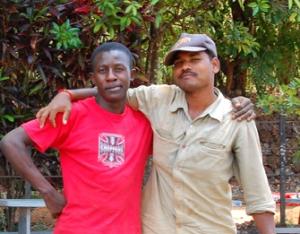 How can soil be used in this modern age where cement is the most trusted and used? Arnold Tingu is a young man from Uganda who is currently interning at the Asia Plateau centre, in Panchgani, India. Arnold is particularly involved with the Grampari centre and in this article he shares his experience of a workshop he attended which focused on the importance of using soil to make earth houses and earth walls.
How can soil be used in this modern age where cement is the most trusted and used? Arnold Tingu is a young man from Uganda who is currently interning at the Asia Plateau centre, in Panchgani, India. Arnold is particularly involved with the Grampari centre and in this article he shares his experience of a workshop he attended which focused on the importance of using soil to make earth houses and earth walls.
It should be noted that soil or earth has been used since civilisation began in modern man, and soil proved to be the most trusted resource due to its strength and reusability. An interesting fact is that the oldest structural building is made of soil which is 650 years old; the oldest cement structure is 150 years old.
Why use soil? Meet the facilitator of the workshop, Mr Sourauh Phadke, he has experience in earth building and anything dealing with soil. He personally lives in an earth walled house built out of soil.
He stressed out how earth built houses are both good and friendly to the environment and they can be reused time after time compared to cement built houses. Besides that, he said, the insulation system is perfect because during hot summers they are cool inside, hence saving power costs on air conditioners and during winter they are warm inside.
Mr Sourauh is an architect by profession and has built many earth houses. The most dramatic experience he has faced is that elephants in an elephant corridor tend to destroy cement built houses but not earth walled houses.
Now one may ask how these earth walled houses are built, how soil compressed bricks are made and what type of soil to use? The technical part can be explained as follows: the soil should be clay in nature. After obtaining the clay soil, sand is needed and cement in some cases. The mixing ratios for soil and sand should be equal e.g. 6 buckets of soil and 6 buckets of sand and a quarter bucket of cement, and then mix until uniform mixture is obtained. Little water is added but a dry mix is required so the water should just make 10% of the mixture.
To make earth walls, a form work is required. Say you want a wall of 3 feet high and 6 feet long then you require a form work of 3 feet high and 6 feet long. Then pour in the mixture in it. It is then rammed until it’s compacted enough to form the wall. Colours can be added by crushing soft stones and charcoal to obtain colours which can be added to the mixture to make it artistic. After compaction the form works can be removed but one should note that before setting the wall a foundation is required. The base should be firm, have good water retaining capacity and no plant growth on the base. This is how one can make earth walls.
The mixture is then poured in a brick compressing machine, pulled manually with one hand and the brick is obtained. The brick compressing machine should have a firm base. When cement is added, curing the bricks is required which takes 22 days.
One may wonder what the purpose for this is and how it can be used. I spoke to Soarhub, since we both belong to the civil field of Engineering and I discovered that he has been doing small projects with rural people because that’s what he feels he needs to do rather than sitting back and seeing people living on streets.
This impressed me and I felt challenged. I also met a doctor who is operating a free clinic to support people. This showed me that we should not just think of ourselves but also our communities. I also learnt that we can do small projects which can make a difference in the community and the world.
I am now thinking about my future and how best I can be of service to my country rather than blaming the government for everything. And with the four moral standards of IofC, i.e. absolute love, absolute honesty, absolute unselfishness and absolute purity, I can bring some small changes in my community.


